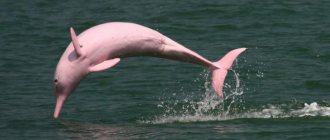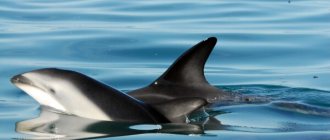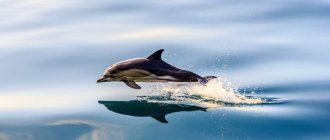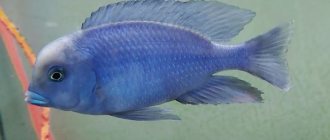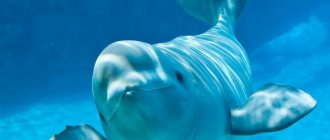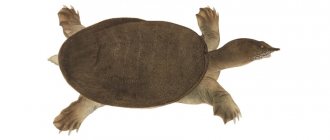Chinese river dolphin baiji. Baiji is a Chinese river dolphin.
People did not hunt the Chinese river dolphin, which lived in the Yangtze rivers of Asia, but were indirectly involved in its extinction. The waters of the river were overflowing with merchant and cargo ships, which simply polluted the river. In 2006, a special expedition confirmed the fact that baiji no longer exists on earth as a species.
.
How the species lives and what it eats
It is very difficult to study the lifestyle of this species. Due to the small number, there is almost no information. What is known is that river dolphins live in pairs and prefer river mouths and shallow coastal waters. Most likely, this is precisely the reason for the poor development of the visual organs in the species. The water here is always muddy, so your eyes are virtually useless and you have to rely on echolocation.
The Chinese river dolphin is diurnal. At night, he moves to areas with a slow current to rest peacefully.
The mammal's diet includes small fish, eels, catfish and shellfish. The animal uses a long beak for hunting. With its help, the dolphin digs prey out of the mud. To crush strong shells, it uses teeth that are specially adapted for this purpose.
Occasionally, river dolphins gather in groups. Such a group can consist of 3 individuals, or it can consist of 15 animals. But these formations are not long-lasting.
What is baiji. Population status
Of course, scientists are trying to preserve endangered animal species, but in the case of the Chinese river dolphin, success has not been achieved. Despite the fact that the species is protected and listed in the Red Book, there are virtually no animals left in nature. The latest evidence of fishermen encounters with this species of dolphin was obtained in. An expedition was sent to collect a certain number of different-sex individuals (about 25 heads). This could allow the species to be propagated in captivity and partially restore the population. But the expedition returned empty-handed. Modern equipment did not record baiji. This leads to a sad conclusion: the river dolphin population has become extinct and cannot be restored. As sad as it is to realize, the Chinese river dolphin is officially recognized as an endangered species.
According to paleontological excavations, river dolphins migrated to the Yangtze about 20,000 years ago. Their first mention dates back to the times. Traditionally, dolphins were protected by custom as they were considered river deities (長江女神) by the ancient Chinese; they have no natural enemies. Modern anthropogenic pressure, including accidental and poaching catches, deaths from collisions with river vessels, and the construction of hydroelectric power stations, which interfere with seasonal migration, have caused severe damage to the dolphin population. Other factors in the decline in numbers were severe chemical and noise pollution of the Yangtze, buildings that impede migration, land drainage, dredging and a reduction in the food supply. The greatest blow to the river dolphin population was the construction of the dam, which changed the Yangtze.
Official protection of the river dolphin began c. Vaughn is declared an endangered species and a national treasure; attack on him was prohibited. (One of the dolphin’s names is “Yangtze.”) However, attempts to keep and breed dolphins in captivity have not been successful. The only specimen, a male named Qiqi (淇淇), caught in Dongting Lake, lived in captivity until July 14. Two other dolphins, captured and placed in conditions close to natural, lived only 1 year and 1 month, respectively.
Baiji interesting facts. Chinese river dolphin
A long time ago, 20 million years ago, dolphins first entered the Yangtze River from the Pacific Ocean. Baiji originated from them.
In traditional Chinese culture, these animals were revered as sacred, but in the twentieth century. everything has changed. Economic and political changes in China led to the extinction of a unique species.
Until recently, there were four species of exclusively freshwater dolphins.
Baiji is one of them. This is the first cetacean to disappear due to human fault. Chinese river dolphins swam in the middle and lower reaches of the Yangtze for 1.7 thousand km. They were also found in the Qiantang River and two lakes. It is not surprising that the baiji came under strong human pressure, since a tenth of the world's population lives in this region of the planet.
Compared to other dolphins, the Chinese river dolphin had a stockier body and a very long and narrow snout. The color of the back was gray-blue, and the belly was white. The Chinese river dolphin disappeared very quickly: in 1950, approximately 6 thousand individuals lived in the waters of the Yangtze, and after 20 years there were already several hundred of them left.
The reason for this is a terrible famine in China, when dolphins were hunted for meat. The subsequent economic surge also did not bring anything good for the baiji. The impact on the river and its inhabitants then became colossal: industrial and noise pollution, shipping, and dam construction. Active fishing also had an impact: aquatic mammals became entangled in nets and died from poachers’ electric fishing rods. As a result, in 2006, a specially organized expedition did not find a single Chinese river dolphin in the Yangtze.
The Three Gorges Dam and one of the world's largest hydroelectric power plants is a symbol of the power of the Chinese economy. The significance of this cyclopean structure for the country is enormous. However, for the animal world of the river, the latest construction project of the century was a terrible blow. Not only has the temperature and hydrology of the Yangtze changed, but the usual habitats for many species have also disappeared. The Chinese river dolphin was also unlucky: scientists believe that the construction of the dam finally put an end to its existence.
Chinese legend says that baiji is the spirit of a princess who died tragically in ancient times: the girl was drowned in a river when she refused to marry someone she didn’t love.
The natives do not hunt rime. Why?
The natives ignore the rime due to the fact that the meat of these river inhabitants is soft and there is almost no fat. Also the reason is the large number
mysterious stories associated with animals. According to one of them, the Amazonian Inia is an evil sorceress who can transform into a young beautiful woman with curly locks. In this guise she lures gullible youths and destroys them.
Local residents say that the sorceress appears in the city of Aigues, where she is looking for her next victim. When she captivates a man with her beauty
, leads him to the river bank, where he hugs the victim, screams loudly and disappears into the watery depths with his admirer.
You can fill lamps with fat, but no one does this. The belief says that a person who does this will go blind or suffer misfortune.
Striped dolphin. Striped dolphin
Stenella coeruleoalba (Striped Dolphin) Order Cetaceans - Cetacea Suborder Toothed whales (Odontoceti) Family Delphinidae - Genus Dolphins (Stenella)
Dolphins (Stenella) are very diverse in color, number of teeth and other structural features. This is the largest genus of the family in terms of the number of species, and many of them are quite common. Experts believe that the taxonomy for this group is poorly designed.
The striped dolphin (Stenella caeruleoalbus) is the best known of the dolphin genus.
Other names: white-bellied, blue-white dolphin. general information
- The status of the species is widespread.
- Habitat: open water and coastal zone.
- The number of groups is 10-500 (1-2000).
- The location of the dorsal fin is in the center.
- The length of a newborn is up to 1 m.
- Newborn weight - unknown
- The length of an adult is 1.8-2.5 m.
- Adult weight - 90-150 kg.
- Diet: fish and cephalopods.
Habitat: Distributed in tropical, subtropical and temperate zones of the World Ocean.
In the Pacific part of its range it is found from the Bering Sea, the coast of North America, the Kuril and Japanese Islands in the north to New Zealand in the south.
In Russian waters it is observed in the Bering Sea and in the Kuril waters. Russian waters are the northern border of the range.
Number and status There is practically no accurate data on the number.
The status of the species is widespread.
Appearance Characteristic: bluish-dark back, light belly and part of the sides.
Narrow dark stripes stretch back from the eyes: one or two to the base of the dark pectoral fin and one to the anus. Dark spot around each eye.
The dorsal fin is dark and strongly curved. The caudal peduncle is narrow and pale gray. The tail lobes are small, pale gray, with curved edges and a notch in the middle.
There are 44-50 teeth in each row (176-200 in total). Lifestyle and nutrition Active look and immediately attracts attention.
Behavior has been studied very poorly. Similar to the behavior of common dolphins.
It is known to form large herds of up to several thousand animals. Often jumps out of the water. Immersed usually for 5-10 minutes. During feeding, it dives up to 200 m in depth. The age of the oldest males studied, judging by the dentin layers of the teeth, reached 45.5 years, and females - 37.5 years.
It feeds on fish and cephalopods.
The voice of a striped dolphin in nature
Striped dolphin and man Single caught in China. In Japan it is a commercial species (about 20,000 individuals are caught per year); sometimes shown to the public.
Description of the species
A freshwater representative of toothed whales, the Chinese river dolphin is a fairly large animal. The maximum recorded body length of a mammal was 2.5 m. And the minimum length of an adult was 1.5 m. The weight of an adult animal can range from 100 to 160 kg. The description of the dolphin is not very detailed. It is known that the females of this species are large and larger in size than the males. The body of dolphins is dense and stocky. The neck is quite mobile. The pectoral fins have a wide base, but seem to be chopped off at the edge with an axe. The dorsal fin is medium in size, with smoothly rounded anterior and posterior edges. It is located not in the middle of the back, but closer to the tail.
An oval-shaped blowhole is located on the crown of the mammal. It is slightly offset to the left of center. The Chinese river dolphin has poor vision. His eyes are poorly developed and rather poorly positioned. They are located high on the head, which reduces the viewing angle.
The anterior part of the brain skull is the so-called rostrum, it is narrow and elongated. It curves slightly upward and resembles the beak of a crane. The upper jaw has fewer teeth than the lower jaw. The maximum number on top is 68 teeth, and on the bottom – 72 teeth.
It is impossible to describe a dolphin without indicating the color of the animal. Baiji is light blue or bluish-gray in color. The animals' bellies are white. Although some eyewitnesses claim that the color is much lighter than in the official description. They say the Chinese river dolphin is almost white.
La Plata dolphin. Lifestyle
La Plata dolphins are found in the coastal waters of the eastern coast of South America from Espirito Santo (Brazil, 18°25′ S) to the Valdes Peninsula (Northern Patagonia, Argentina, 42°30′ S), as well as in mouth of La Plata. This is the only river dolphin found in salty sea waters. The distribution is associated with seasonal migrations: in winter, some dolphins leave La Plata and wander north along the coast of the mainland. Judging by observations and accidental catches, La Plata dolphins inhabit a narrow strip of warm coastal waters to a depth of 30 m, which is richest in food.
Based on minor morphological and genetic differences, two populations of the La Plata dolphin are distinguished:
- a smaller northern form found between Rio de Janeiro and Santa Catarina,
- the larger southern form is from Rio Grande do Sul to Argentina.
The ecology of the species has been poorly studied. Like other river dolphins, they hunt bottom fish by burrowing in the ground with their long beaks. The diet is based on fish from the croaker family (Sciaenidae). In Uruguay waters, dolphins feed primarily on the striped croaker (Cynoscion striatus); in Brazil also by the species Paralonchurus brasiliensis, Macrodon ancylodon and Micropongonias furnieri. Females are more likely to eat squid (Loligo sanpaulensis) than males. Juveniles also feed on shrimp (Artemesia longinaris). The dolphins themselves are hunted by killer whales and some species of sharks. For hunting and orientation under water, echolocation is used; echolocation clicks resemble those of the porpoise.
They live alone or in small groups (up to 15 heads). La Plata dolphins are very quiet and secretive; monitoring them is difficult. They do not display the usual acrobatic abilities of dolphins.
Reproduction
The reproduction of this species has been little studied. The mating period occurs in December-February, childbirth in September-December. Pregnancy lasts 9-10.5 months. The only cub is miniature, about 75-80 cm long and weighs 7.3-8.5 kg. Lactation continues until August-September of the next year. Puberty occurs at 2-3 years. The female brings offspring once every 2 years.
The age of the oldest female caught was estimated at 13 years, the male at 16 years. Life expectancy in nature is estimated to be 18-20 years.
Reproduction
There is too little information about the reproduction of Chinese river dolphins. Scientists make guesses based on the bits of data they have at their fingertips. Females are not very fertile. They give birth to one cub and no more often than once every 2 years. Most likely, the gestation period is 11 months. The cubs are born too weak. At first, the mother is forced to keep them afloat with her fins.
The exact timing of puberty is not known. It is believed that this may occur between three and eight years of age.
Gangetic dolphin or susuk (lat. Platanista gangetica)
Many species of river dolphins are quite different in appearance from their sea counterparts. Many of them, including the Gangetic dolphin, are characterized by a long narrow beak, poor eyesight and excellent echolocation. But where did this strange name - susuk - come from?
Ganges river dolphin or Shushuk (lat. Platanista gangetica)
The fact is that while breathing, the dolphin makes an unusual sound, similar to “susuk”.
The natural habitat of these dolphins is the basins of the Ganges, Brahmaputra, Hooghly, Meghna, Karnaphuli rivers, as well as the Indus River basin. As for the latter habitat, in the Indus the largest number of these river dolphins is located in the lower reaches. This is due to the fact that the river along its entire length is divided by several dams. During the rainy seasons, when the water level rises, dolphins can easily swim through the open gates of the dams, but a strong current prevents them from returning back.
Ganges - sacred river
Externally, Gangetic dolphins are somewhat similar to Amazonian dolphins. They also have a dense body, the length of which reaches 2-2.5 meters, a long and narrow beak, and a steep frontal protrusion. Their weight reaches 70-90 kilograms. The color is uniform, dark gray, sometimes almost black, lighter on the belly.
The susuk does not have a dorsal fin. Instead there is a low triangular hump. The caudal and pectoral fins are quite large compared to the body.
Large pectoral fins
The long and narrow beak is perfect for searching for prey in the bottom soil, and the long front teeth are an excellent means of holding caught prey. They are visible even when the dolphin closes its mouth.
Susuk sees very poorly. Due to living in turbid water, the lens was almost completely lost, and the optic nerve was degraded. In fact, these dolphins are practically blind, although they can still discern the intensity and direction of light. In water they navigate and hunt using highly developed echolocation. During the day they prefer to stay at a depth of about 3 meters, and at night they swim in shallow water, where they sometimes have to swim sideways. They cannot stay under water for a long time; every 35-40 seconds they try to rise to the surface to take a breath of fresh air. But sometimes their stay under water can reach 2 minutes.
They do not differ in swimming speed, but during the hunt they are capable of high-speed jerks. Like all dolphins, susuks feed on fish, most often carp, gobies or catfish, as well as mollusks and crustaceans. They detect prey using echolocation.
These mammals are solitary. Occasionally, a small group of 3-10 dolphins can be observed, which most often forms in feeding areas or in places with weak currents near villages.
As for the reproduction process, its biology is still poorly understood. It is known that most births of cubs occur between October and March. Females carry 1 cub for 8-11 months. It is born about 45-70 centimeters in length and weighs 7-7.5 kilograms. They reach sexual maturity at 6-10 years of age.
Rescue of a baby Gangetic dolphin
Susuki are long-lived. Their lifespan is about 30 years.
Despite the fact that these animals have few natural enemies, in most cases they are crocodiles, Gangetic dolphins are listed in the International Red Book as an endangered species. The main reasons for the decline in their numbers are: catching dolphins for their meat and fat, which is considered an aphrodisiac, death in fishing nets or in collisions with passing ships, irrigation work and water abstractions, as well as the construction of dams and dams.
Notes[ | ]
- Complete illustrated encyclopedia. "Mammals" Book. 1 = The New Encyclopedia of Mammals / ed. D. MacDonald. - M.: Omega, 2007. - P. 219. - 3000 copies. — ISBN 978-5-465-01346-8.
- ↑ 1 2 3 Sokolov V. E.
Five-language dictionary of animal names. Mammals. Latin, Russian, English, German, French. / under the general editorship of academician. V. E. Sokolova. - M.: Rus. lang., 1984. - P. 112. - 352 p. — 10,000 copies. - Tomilin A.G.
Order Cetacea (Cetacea) // Animal Life. Volume 7. Mammals / ed. V. E. Sokolova. — 2nd ed. - M.: Education, 1989. - P. 371. - 558 p. — ISBN 5-09-001434-5. - Biological encyclopedic dictionary / Ch. ed. M. S. Gilyarov; Editorial team: A. A. Baev, G. G. Vinberg, G. A. Zavarzin and others - M.: Sov. encyclopedia, 1986. - pp. 539-540. — 831 p. — 100,000 copies.
- Sokolov V. E.
Systematics of mammals. Volume 3. Cetaceans, carnivores, pinnipeds, aardvarks, proboscideans, hyraxes, sirens, artiodactyls, callouseds, odd-toed ungulates. - M.: Higher School, 1979. - P. 19. - 528 p. - Sokolov V. E.
Rare and endangered animals. Mammals: Reference. allowance. - M.: Higher School, 1986. - P. 227. - 519 p., [24] l. ill. — 100,000 copies. - Sokolov V. E.
Fauna of the world: Mammals: Directory. - M.: Agropromizdat, 1990. - P. 125. - 254 p. — ISBN 5-10-001036-3. - ↑ 1 2 3 4 5 6 7 Nanjing Normal University Kaiya Zhou (College of Life Sciences, Brian Smith, Randall Reeves (IUCN SSC Cetacean Specialist Group), Gillian Braulik, Jay Barlow, Southwest Fisheries Science Center/NOAA) Robert Pitman (Protected Resources Division.
IUCN Red List of Threatened Species: Lipotes vexillifer
(unspecified)
.
IUCN Red List of Threatened Species
(August 20, 2017). Accessed: May 3, 2022. - Rare Dolphin Seen in China, Experts Say, New York Times (August 30, 2007). Retrieved August 30, 2007.
- baiji.org foundation - Overview Archived January 4, 2007.
- Yongchen Wang.
Farewell to the baiji
(undefined)
.
China Dialogue
(January 10, 2007).
White dolphin of the Black Sea
Seeing a dolphin is a delight for the soul, and seeing a white one is a thrilling experience. The white bottlenose dolphin, perhaps the only one in the Black Sea, often cruises near Sudak and the village of Novy Svet. It can be assumed that this is an albino dolphin (albinism is a congenital absence of pigment in the skin, hair, and eye membranes). But there is another point of view. “Most likely, this is not an albino, but a white dolphin,” says Elena Gladilina, a graduate student at the Department of Zoology of the Taurida National University. “Albinos are weaker animals, they never occupy leading positions. The white bottlenose dolphin is very active; according to my observations, it dominates the dolphins of its group. By the way, it is in this water area that we often see dolphins with white spots, this is a consequence of some genetic abnormalities.” And in my amateurish opinion, the white bottlenose dolphin is a precious gift from nature. And to admire it is great luck. Until the peninsula regained its dolphin fairy tale... Which, for example, Countess Gorchakova had a chance to see in the 19th century: “... hundreds of dolphins frolicked under the rays of the dazzling sun; they jumped, circled, on the surface of the blue waters, cut the waves with their black tails and, catching up with each other, raised whole fountains of golden streams behind them.” V. A merciless large-scale fishery began, millions of animals were destroyed, and they were processed into livestock feed. This chaos has stopped, but the dolphins still need our protection. They are put on flounder and die from disease... Smart animals of the Black Sea ask man to be an intelligent and caring creature. Margarita ANGARSKAYA, And a little video with a white dolphin. Other bottlenose dolphins in this group have white spots on their bodies and fins.
Links[ | ]
- Lake dolphin on the website Whales and Dolphins
- Gray whale on the website Primorsky Krai of Russia
- Lipotes vexillifer on Animal Diversity Web
- Lipotes vexillifer on Animalinfo website
- Lake dolphin on the website Cetacea.org (archive)
- US National Marine Fisheries Service baiji web page
- whale-web.com
- US Fish & Wildlife Service Species Profile
- Lipotes vexillifer
, Endangered and Protected Species Database of Chinese Animals - World Wide Fund for Nature (WWF) – species profile for River Dolphins (inaccessible link)
- Save the Baji
- Photos in Hudong
- NULL Hypothesis "RIP Yangtse River Dolphin"
- BBC News "Last chance for China's dolphin"
- BBC News "Failure in Yangtze dolphin search"
- The Baiji Foundation "Hope dies last"
- Baiji is functionally extinct
- Search for baiji
- New Scientist “Yangtze river dolphin is almost certainly extinct”
- China's White Dolphin Likely Extinct
- Scientific American August 08, 2007, “Requiem for a Freshwater Dolphin”
| The article contains a list of sources, but lacks footnotes . Without footnotes, it is difficult to determine which source each individual statement comes from. You can improve the article by providing footnotes to sources that support the information. Information without footnotes may be deleted. |
River Dolphins. general characteristics
The river dolphin, when compared with its sea relatives, is more primitive. The brain has fewer convolutions. Short and wide pectoral fins, the absence of a dorsal fin (instead there is an elongated crest), a very narrow snout, a long symphysis of the lower jaw - all these are features of its ancient ancestors, squalodonts.
The free arrangement of the cervical vertebrae allows river dolphins to turn their heads 90° relative to their body. They feed on fish, shellfish and worms, which they catch not only in water. Using a snout covered with a layer of hard tactile hairs, they are able to sense prey in the depths of the muddy bottom and dig it out. Unlike touch, their vision, on the contrary, is quite weak. But the hearing and echolocation apparatuses are very developed. It is with their help that river dolphins receive information about the world around them.
If we talk about the habitat, then it can be called relict and broken. The family is represented by two monotypic genera inhabiting the tropical rivers of South America, and two genera inhabiting the rivers of India and China. Next, we will consider the species of river dolphins discovered by zoologists today.
White-sided dolphin. White-sided dolphin
The white-sided dolphin, or common dolphin, is up to two meters long and weighs from forty to sixty kilograms. Most often found on the open sea. If the end of the bottlenose dolphin's head resembles the neck of a bottle, then the white sided dolphin has an elongated snout, reminiscent of a beak. The body is blue-black, white on the sides, which is why they call the white-sided dolphin.
This species of toothed cetacean has other names - short-beaked, blubber, tyrtak, sharp-faced, common dolphin. But despite all this, it is the most widespread species in the world's oceans. It lives in the Sea of Okhotsk, the Sea of Japan and the Baltic Sea, in the open water of northern latitudes, the Atlantic, Pacific and Indian oceans. It’s easier to name where it is not.
Its large population is found in the Black Sea. But far from the shores. Holidaymakers crowded onto the beach. They point their fingers animatedly at the oncoming waves. They make noise, take pictures, film something. Looking closely into the surf, you see, about thirty meters from the shore, seemingly sedate sea animals, either plunging into the water or emerging from it. These are bottlenose dolphins. They cruise along the coast in search of food. When they see a joint, they transform both externally and internally. They become fast-paced and passionate. He grabbed the fish with his sharp teeth, and it was gone - it disappeared into the mouth. And then again there was an imposing air and a kind of sedateness in swimming. Whiteside is not like that. You almost never see it off the coast. Her element is the open sea. If you bought a ticket for one of our sea vessels, which regularly approach the piers to take you, for example, to the dolphinarium on Bolshaya Utrish or take you on an hour-long ride through the waves - here you will certainly encounter white sided whales. The ship moved a decent distance from the beaches, picked up speed, and suddenly a cheerful school of dolphins appeared in front of its bow. Beautiful, slender, fast, streamlined, somewhat similar in shape to a spindle, they look at you and people with funny, intelligent eyes and seem to ask: “Well, who’s who…” You can’t keep up with them. So they will accompany you all the way to Big Utrish, their white sides sparkling, which is why they are nicknamed “squirrels”.
